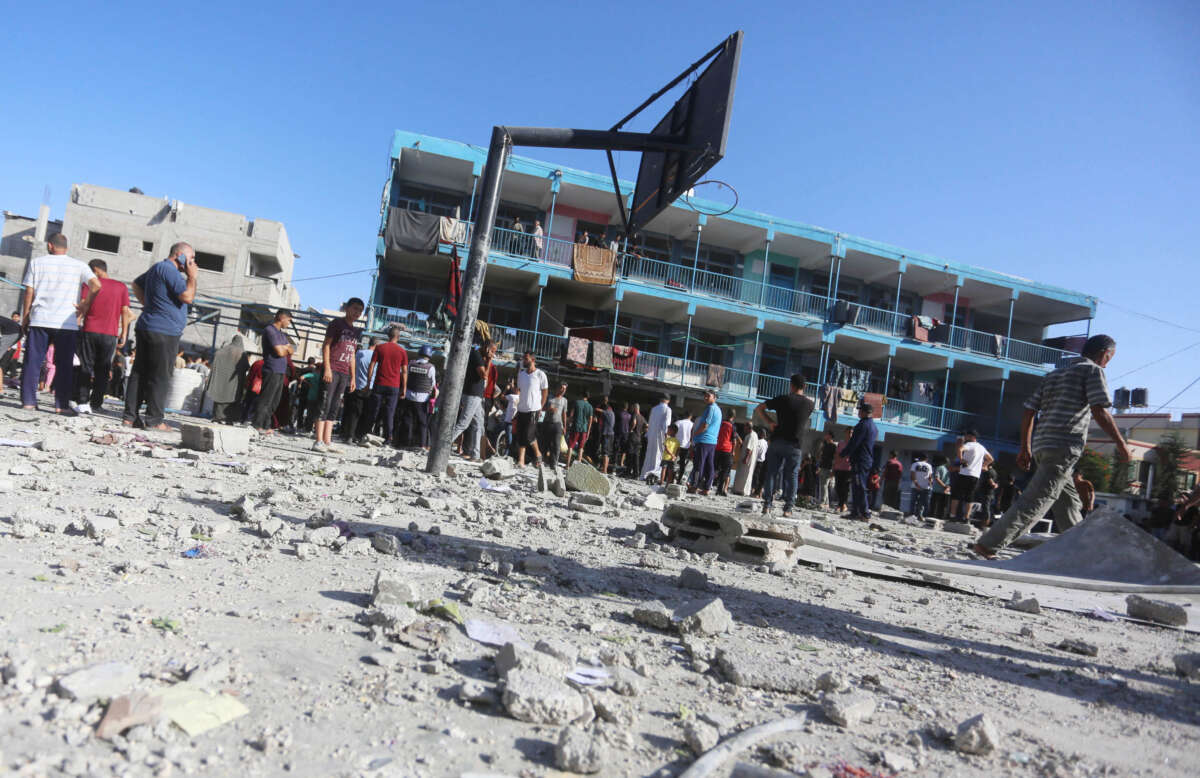Israeli forces struck the crowded area of Gaza that they designated a “safe zone” for the second time in two days on Wednesday, striking a school that was specifically marked as a humanitarian safe area in the Nuseirat refugee camp in central Gaza.
The strike on the UN-run al-Jaouni school killed at least 18 people and injured at least 18 more, according to initial reports by Palestinian officials. The school serves as a shelter for 12,000 Palestinians.
Six UN employees were killed in the strike, according to the UN Relief and Works Agency for Palestine Refugees (UNRWA), making it the single deadliest strike for the agency since the genocide began.
According to UN spokesperson Stéphane Dujarric, the school was deconflicted, meaning that the UN had arranged for it to be off-limits from Israeli attacks, potentially because it was being used for humanitarian operations or shelter for aid workers.
This means that, according to Israel’s own designations, the school had two layers of protection — being deconflicted and being in the safe zone — but was subject to an Israeli attack nonetheless, showing Israel’s continued disregard for even its own stated rules of engagement, much less the ones set up by international law.
The strike caused a “tremendous size of destruction” to the school-turned-evacuation center, Al Jazeera reports. Since the beginning of August, Israel has struck schools at least 17 times across Gaza. According to UNRWA, this is the fifth time al-Jaouni has been hit by Israeli forces.
The ever-shrinking “safe” zone encompasses only about 11 percent of Gaza’s land area, now housing at least 1.7 million Palestinians who have been forced out of their homes by Israel in the past 11 months. The area is extremely crowded, with very little room for movement and disease spreading quickly through the cramped quarters.
It was this dense area that Israel bombed early in the morning on Tuesday, killing at least 19 Palestinians taking shelter in a tent camp in the desert area of al-Mawasi. The attack, carried out using multiple 2,000 pound bombs fitted with U.S. equipment, wounded many, with many others likely buried in the sand or simply unable to be tallied because the blast tore their bodies to pieces.
The attack left gigantic craters in the ground, going as deep as 15 meters, or 49 feet, according to Al Jazeera.
Humanitarian groups said that the attack, likely a war crime, is a show that the “safe” zone in Gaza is anything but safe. Indeed, Israel has struck the “safe” zone at least a dozen times since it was first designated by Israeli forces in May.
The al-Jaouni school, meanwhile, is Israel’s latest attack on humanitarian workers. Israeli forces have killed 214 UN Relief and Works Agency for Palestine Refugees (UNRWA) workers since their genocide started, not including the workers potentially killed in Wednesday’s strike.
Our most important fundraising appeal of the year
December is the most critical time of year for Truthout, because our nonprofit news is funded almost entirely by individual donations from readers like you. So before you navigate away, we ask that you take just a second to support Truthout with a tax-deductible donation.
This year is a little different. We are up against a far-reaching, wide-scale attack on press freedom coming from the Trump administration. 2025 was a year of frightening censorship, news industry corporate consolidation, and worsening financial conditions for progressive nonprofits across the board.
We can only resist Trump’s agenda by cultivating a strong base of support. The right-wing mediasphere is funded comfortably by billionaire owners and venture capitalist philanthropists. At Truthout, we have you.
We’ve set an ambitious target for our year-end campaign — a goal of $250,000 to keep up our fight against authoritarianism in 2026. Please take a meaningful action in this fight: make a one-time or monthly donation to Truthout before December 31. If you have the means, please dig deep.
